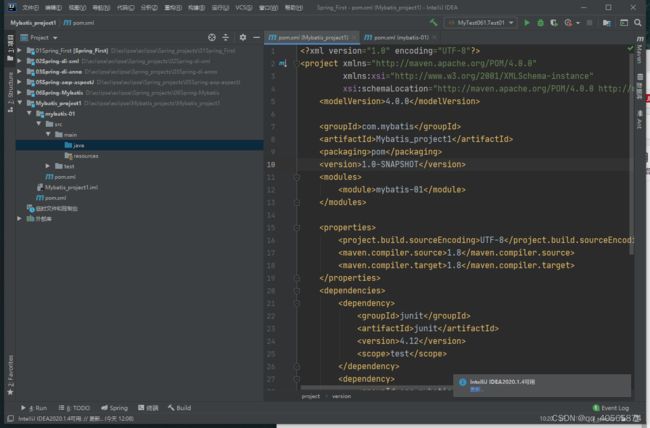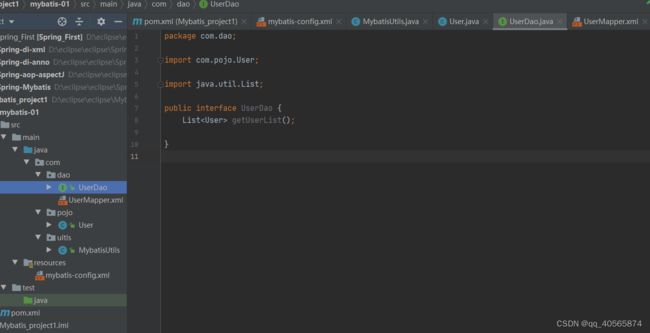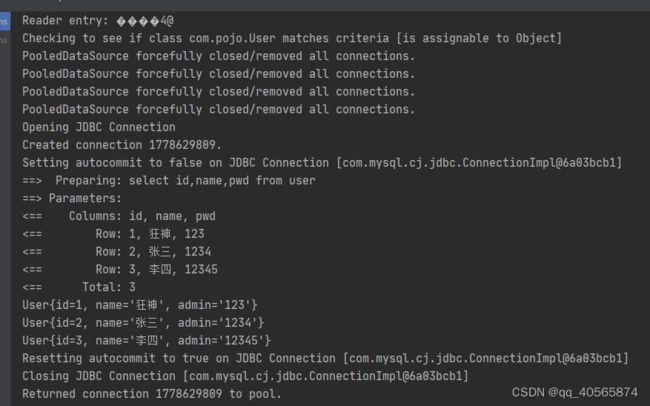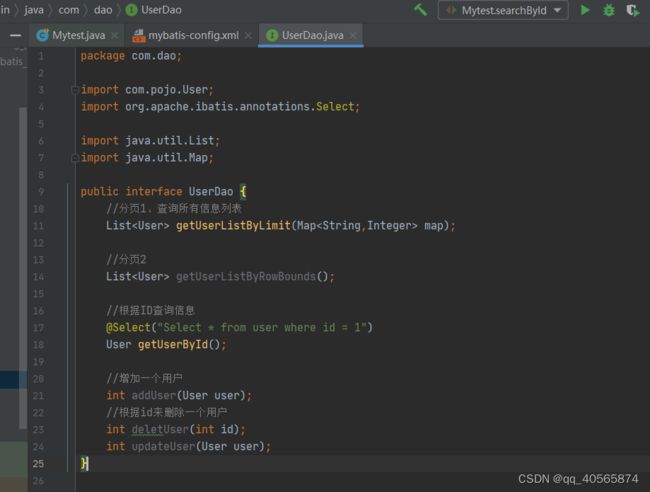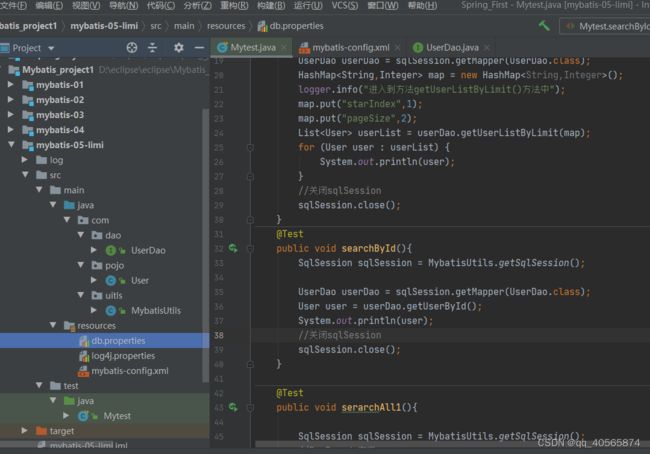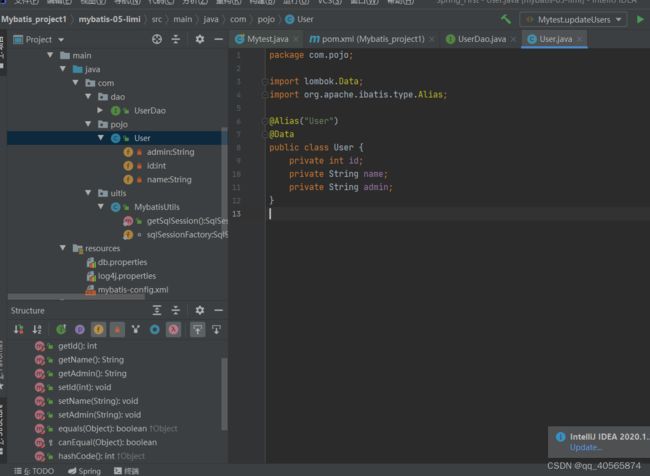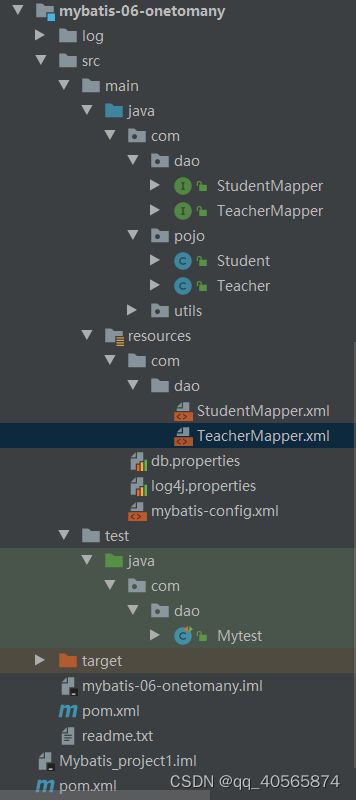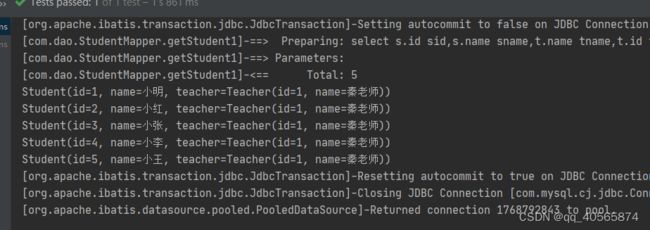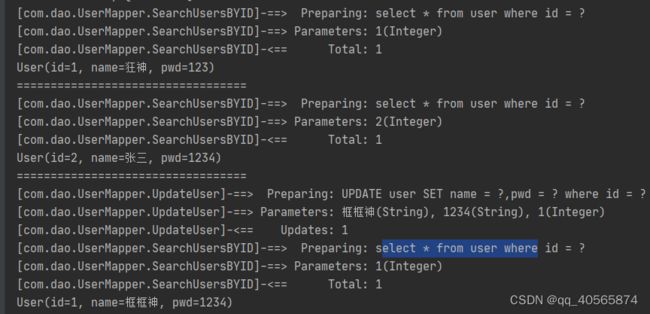Mybatis学习
Mybatis:
环境:JDK1.8、MySQL5.7、maven3.6.1、IDEA
回顾:JDBC、MySQL
java基础
maven
Junit
SSM框架:配置文件的。最好的方式:看官网文档
1.1、Mybatis简介:
MyBatis 是一流的持久性框架,支持自定义 SQL、存储过程和高级映射。MyBatis 消除了几乎所有的 JDBC 代码和手动设置参数和检索结果。MyBatis 可以使用简单的 XML 或 Annotations 进行配置和映射原语、映射接口和 Java POJO(普通旧 Java 对象)到数据库记录。
现在迁移到GitHub中。
如何获得Mybatis,maven仓库,或者GitHub中下载。
查看maven的使用依赖插件的坐标网站:https://mvnrepository.com/
maven仓库:
<!-- https://mvnrepository.com/artifact/org.mybatis/mybatis -->
<dependency>
<groupId>org.mybatis</groupId>
<artifactId>mybatis</artifactId>
<version>3.4.6</version>
</dependency>
1.2、持久层
数据持久化
- 持久化就是将程序的数据在持久状态和瞬间状态转化的过程
- 内存:断点即失
- 数据库(JDBC),IO文件持久化
- 生活:冷藏.罐头。
为什么需要持久化? - 有一些对象,不能让他丢掉。
- 内存太贵了
1.3、持久层
Dao层,Service层,controller层
- 完成持久化工作的代码块
- 层界限十分明显
1.4、为什么需要Mybatis?
- 方便
- 传统的JDBC代码太复杂了。简化。框架。自动化。
- 帮助程序员将数据存入到数据库中。
- 不用Mybatis也可以。更容易上手。技术没有高低之分
- 优点:简单易学、灵活、解除SQL与程序代码的耦合,SQL和代码的分离,提高可维护性、提供映射标签,支持对象与数据库的orm字段关系映射、提供对象关系映射标签、支持对象关系组件维护、提供xml标签,支持编写动态sql。
最重要的一点:使用的人多!就是为了使用。
2、第一个Mybatis程序
思路:搭建环境–》导入Mybatis–》编写代码–》测试!
2.1搭建环境
搭建数据库:
CREATE DATABASE mybatis;
USE mybatis;
CREATE TABLE user(
id INT(20) NOT NULL,
name VARCHAR(30) not NULL,
pwd VARCHAR(30) DEFAULT NULL,
PRIMARY KEY(id)
)ENGINE=INNODB DEFAULT CHARSET=utf8;
INSERT INTO user (id,name,pwd) VALUES
(1,'狂神','123'),
(2,'张三','1234'),
(3,'李四','12345')
新建一个普通的maven项目:
1、新建一个普通的maven项目
2、删除src目录
3、导入maven依赖
<properties>
<project.build.sourceEncoding>UTF-8</project.build.sourceEncoding>
<maven.compiler.source>1.8</maven.compiler.source>
<maven.compiler.target>1.8</maven.compiler.target>
</properties>
<dependencies>
<dependency>
<groupId>junit</groupId>
<artifactId>junit</artifactId>
<version>4.12</version>
<scope>test</scope>
</dependency>
<dependency>
<groupId>org.mybatis</groupId>
<artifactId>mybatis</artifactId>
<version>3.5.2</version>
</dependency>
<dependency>
<groupId>mysql</groupId>
<artifactId>mysql-connector-java</artifactId>
<version>8.0.29</version>
</dependency>
</dependencies>
2.2、创建一个模块
- 编写Mybatis核心配置文件
<?xml version="1.0" encoding="UTF-8" ?>
<!DOCTYPE configuration
PUBLIC "-//mybatis.org//DTD Config 3.0//EN"
"http://mybatis.org/dtd/mybatis-3-config.dtd">
<!--核心配置文件-->
<!--注意URL的配置:配置时区-->
<configuration>
<environments default="development">
<environment id="development">
<transactionManager type="JDBC"/>
<dataSource type="POOLED">
<property name="driver" value="com.mysql.cj.jdbc.Driver"/>
<property name="url" value="jdbc:mysql://localhost:3306/mybatis?useSSL=true&useUnicode=true&characterEncodign=UTF-8;serverTimezone=UTC"/>
<property name="username" value="root"/>
<property name="password" value="admin"/>
</dataSource>
</environment>
</environments>
<mappers>
<mapper resource="org/mybatis/example/BlogMapper.xml"/>
</mappers>
</configuration>
- 编写Mybatis工具类
package com.uitls;
import org.apache.ibatis.io.Resources;
import org.apache.ibatis.session.SqlSession;
import org.apache.ibatis.session.SqlSessionFactory;
import org.apache.ibatis.session.SqlSessionFactoryBuilder;
import java.io.IOException;
import java.io.InputStream;
/*每个 MyBatis 应用程序都以 SqlSessionFactory 实例为中心。
可以使用 SqlSessionFactoryBuilder 获取 SqlSessionFactory 实例。
SqlSessionFactoryBuilder 可以从 XML 配置文件或从 Configuration 类的自定义准备实例构建 SqlSessionFactory 实例。*/
//sqlSessionFactory ---》SqlSession实例
//SqlSession完全包含了面型数据库执行SQL命令所需的所有方法。你可以通过SqlSession实例来直接执行已映射的SQL语句
public class MybatisUtils {
private static SqlSessionFactory sqlSessionFactory;//提升作用域
{
try {
//使用Mybatis第一步:获取sqlSessionFactory
String resource = "mybatis-config.xml";
InputStream inputStream;
inputStream = Resources.getResourceAsStream(resource);
sqlSessionFactory = new SqlSessionFactoryBuilder().build(inputStream);
} catch (IOException e) {
e.printStackTrace();
}
}
public static SqlSession getSqlSession() {
//返回SQLSession对象
return sqlSessionFactory.openSession();
}
}
2.3编写代码
- 实体类
package com.pojo;
public class User {
private int id;
private String name;
private String pwd;
public int getId() {
return id;
}
public void setId(int id) {
this.id = id;
}
public String getName() {
return name;
}
public void setName(String name) {
this.name = name;
}
public String getPwd() {
return pwd;
}
public void setPwd(String pwd) {
this.pwd = pwd;
}
@Override
public String toString() {
return "User{" +
"id=" + id +
", name='" + name + '\'' +
", pwd='" + pwd + '\'' +
'}';
}
}
package com.dao;
import com.pojo.User;
import java.util.List;
public interface UserDao {
List<User> getUserList();
}
- 接口实现类由原来的UserDaoImply转变成一个Mapper文件
<?xml version="1.0" encoding="UTF-8" ?>
<!DOCTYPE mapper
PUBLIC "-//mybatis.org//DTD Mapper 3.0//EN"
"http://mybatis.org/dtd/mybatis-3-mapper.dtd">
<!--namespace=绑定一个对应的Dao/Mapper接口-->
<mapper namespace="com.dao.UserDao">
<select id="getUserList" resultType="com.pojo.User">
select * from user
</select>
</mapper>
Junit单元测试:
import com.dao.UserDao;
import com.pojo.User;
import com.uitls.MybatisUtils;
import org.apache.ibatis.session.SqlSession;
import org.junit.Test;
import java.util.List;
public class Mytest {
@Test
public void test(){
//1.获取SqlSession对象
SqlSession sqlSession = MybatisUtils.getSqlSession();
//2.执行SQL
// 方式一:getMapper
UserDao userDao = sqlSession.getMapper(UserDao.class);
List<User> userList = userDao.getUserList();
for (User user : userList) {
System.out.println(user);
}
//关闭sqlSession
sqlSession.close();
}
}
执行结果:
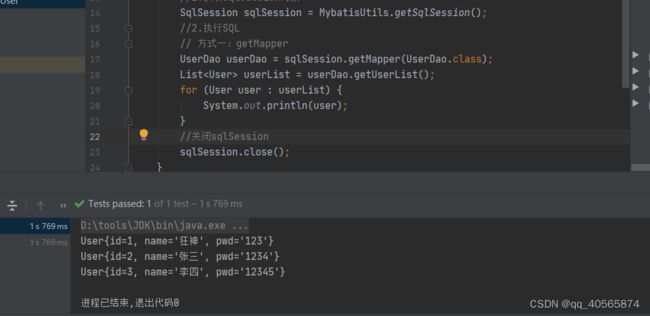
可能会遇到的问题:
1.配置文件没有注册
2.绑定接口错误
3.方法名不对
4.返回类型不对
5.Maven导出资源问题
3、CURD
1、namespace**
namespace中的包名要和Dao/Mapper接口的包名一致
2. select
选择,查询语句;
id:就是对应的namespace中的方法名;
resultType : Sql语句执行的返回值;
parameterType : 参数类型;
1.编写接口
```java在这里插入代码片
public interface UserMapper {
//查询所有用户
public List getUserList();
//插入用户
public void addUser(User user);
}
2.编写对应的mapper中的sql语句
```java
insert into user (id,name,password) values (#{id}, #{name}, #{password})
3.测试
@Test
public void test2() {
SqlSession sqlSession = MybatisUtils.getSqlSession();
UserMapper mapper = sqlSession.getMapper(UserMapper.class);
User user = new User(3,"黑子","666");
mapper.addUser(user);
//增删改一定要提交事务
sqlSession.commit();
//关闭sqlSession
sqlSession.close();
}
注意:增删改查一定要提交事务
sqlSession.commit();
4、 万能Map
假设,我们的实体类,或者数据库中的表,字段或者参数过多,我们应该考虑使用Map!
//用万能Map插入用户
public void addUser2(Map<String,Object> map);
<!--对象中的属性可以直接取出来 传递map的key-->
<insert id="addUser2" parameterType="map">
insert into user (id,name,password) values (#{userid},#{username},#{userpassword})
</insert>
@Test
public void test3(){
SqlSession sqlSession = MybatisUtils.getSqlSession();
UserMapper mapper = sqlSession.getMapper(UserMapper.class);
HashMap<String, Object> map = new HashMap<String, Object>();
map.put("userid",4);
map.put("username","王虎");
map.put("userpassword",789);
mapper.addUser2(map);
//提交事务
sqlSession.commit();
//关闭资源
sqlSession.close();
}
Map传递参数,直接在sql中取出key即可! 【parameter=“map”】
对象传递参数,直接在sql中取出对象的属性即可! 【parameter=“Object”】
只有一个基本类型参数的情况下,可以直接在sql中取到
多个参数用Map , 或者注解!
4、配置解析
1、核心配置文件
- mybatis-config.xml
- Mybatis的配置文件包含了会深深影响MyBatis行为的设置和属性信息。
configuration(配置)
properties(属性)
settings(设置)
typeAliases(类型别名)
typeHandlers(类型处理器)
objectFactory(对象工厂)
plugins(插件)
environments(环境配置)
environment(环境变量)
transactionManager(事务管理器)
dataSource(数据源)
databaseIdProvider(数据库厂商标识)
mappers(映射器)
2、 环境配置 environments
MyBatis 可以配置成适应多种环境
不过要记住:尽管可以配置多个环境,但每个 SqlSessionFactory 实例只能选择一种环境
学会使用配置多套运行环境!
MyBatis默认的事务管理器就是JDBC ,连接池:POOLED
3、属性 properties
我们可以通过properties属性来实现引用配置文件
这些属性可以在外部进行配置,并可以进行动态替换。你既可以在典型的 Java 属性文件中配置这些属性,也可以在 properties 元素的子元素中设置。【db.poperties】
1.编写一个配置文件
db.properties
driver=com.mysql.cj.jdbc.Driver
url=jdbc:mysql://localhost:3306/mybatis?userSSL=true&useUnicode=true&characterEncoding=UTF-8&serverTimezone=UTC
username=root
password=root
<!--引入外部配置文件-->
<properties resource="db.properties">
<property name="username" value="root"/>
<property name="pwd" value="123"/>
</properties>
1.可以直接引入外部文件
2.可以在其中增加一些属性配置
3.如果两个文件有同一个字段,优先使用外部配置文件的
4. 类型别名 typeAliases
类型别名可为 Java 类型设置一个缩写名字。 它仅用于 XML 配置.
意在降低冗余的全限定类名书写。
<!--可以给实体类起别名-->
<typeAliases>
<typeAlias type="com.kuang.pojo.User" alias="User"/>
</typeAliases>
也可以指定一个包,每一个在包 domain.blog 中的 Java Bean,在没有注解的情况下,会使用 Bean 的首字母小写的非限定类名来作为它的别名(大写也可以但是推荐小写)。 比如 domain.blog.Author 的别名为 author,;若有注解,则别名为其注解值。见下面的例子:
<typeAliases>
<package name="com.kuang.pojo"/>
</typeAliases>
在实体类比较少的时候,使用第一种方式。
如果实体类十分多,建议用第二种扫描包的方式。
第一种可以DIY别名,第二种不行,如果非要改,需要在实体上增加注解。
@Alias("author")
public class Author {
...
}
5. 设置 Settings
这是 MyBatis 中极为重要的调整设置,它们会改变 MyBatis 的运行时行为。
6. 其他配置
typeHandlers(类型处理器)
objectFactory(对象工厂)
plugins 插件
mybatis-generator-core
mybatis-plus
通用mapper
7、映射器(mappers)
MapperRegistry:注册绑定我们的Mapper文件;
方式一:【推荐使用】
<!--每一个Mapper.xml都需要在MyBatis核心配置文件中注册-->
<mappers>
<mapper resource="com/kuang/dao/UserMapper.xml"/>
</mappers>
方式二:使用class文件绑定注册
<!--每一个Mapper.xml都需要在MyBatis核心配置文件中注册-->
<mappers>
<mapper class="com.kuang.dao.UserMapper"/>
</mappers>
注意点:
接口和他的Mapper配置文件必须同名
接口和他的Mapper配置文件必须在同一个包下
方式三:使用包扫描进行注入
<mappers>
<package name="com.kuang.dao"/>
</mappers>
8、作用域和生命周期

声明周期和作用域是至关重要的,因为错误的使用会导致非常严重的并发问题
SqlSessionFactoryBuilder:
一旦创建了SqlSessionFactory,就不再需要它了
局部变量
SqlSessionFactory:
说白了就可以想象为:数据库连接池
SqlSessionFactory一旦被创建就应该在应用的运行期间一直存在,没有任何理由丢弃它或重新创建一个实例。
因此SqlSessionFactory的最佳作用域是应用作用域(ApplocationContext)。
最简单的就是使用单例模式或静态单例模式。
SqlSession:
连接到连接池的一个请求
SqlSession 的实例不是线程安全的,因此是不能被共享的,所以它的最佳的作用域是请求或方法作用域。
用完之后需要赶紧关闭,否则资源被占用!
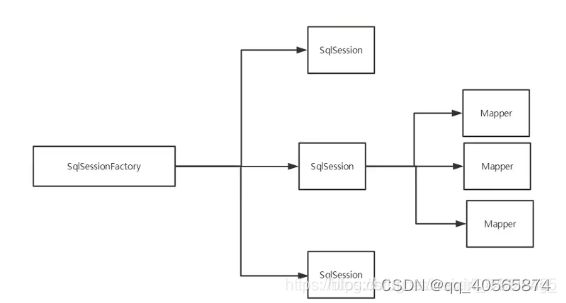
5、解决属性名和字段名不一致的问题
<select id="getUserById" parameterType="int" resultType="good">
select id,name,pwd as password from user where id = #{id}
</select>
2、resultMap
结果集映射:
<resultMap id="UserMap" type="User">
<!--resultmap结果集映射,collum数据库中的字段,property实体类中的属性-->
<result column="id" property="id"></result>
<result column="name" property="name"></result>
<result column="pwd" property="admin"></result>
</resultMap>
<select id="getUserList" resultMap="UserMap">
select id,name,pwd from user
</select>
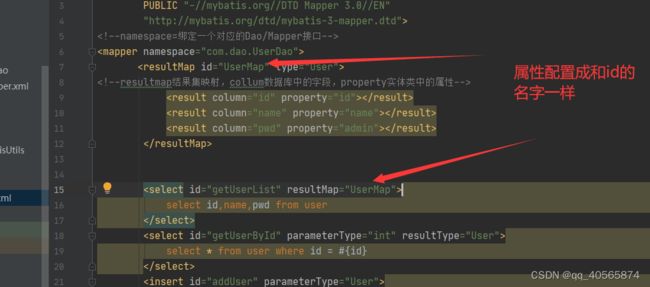
Mybatis会在幕后自动创建一个ResultMap,再基于属性名来映射列到Javabean的属性上,如果列名和属性名没有精确匹配,可以在SELECT语句中对列使用别名俩匹配标签。我们选择使用ResultMap来解决问题,只需要映射属性名和字段名不同的地方。
6、日志
6.1日志工厂
如果一个数据库操作,出现了异常,我们需要排错,日志就是最好的助手!
曾经:sout、debug
现在:日志工厂
![]()
SLF4J
LOG4J 【掌握】
LOG4J2
JDK_LOGGING
COMMONS_LOGGING
STDOUT_LOGGING 【掌握】
NO_LOGGING
在MyBatis中具体使用哪一个日志实现,在设置中设定
配置日志实现为:STDOUT_LOGGING
<settings>
<setting name="logImpl" value="STDOUT_LOGGING"/>
</settings>
6.2 Log4j
什么是Log4j?
- Log4j是Apache的一个开源项目,通过使用Log4j,我们可以控制日志信息输送的目的地是控制台、文件、GUI组件;
- 我们也可以控制每一条日志的输出格式;
- 通过定义每一条日志信息的级别,我们能够更加细致地控制日志的生成过程;
- 最令人感兴趣的就是,这些可以通过一个配置文件来灵活地进行配置,而不需要修改应用的代码。
1.先导入log4j的包
<dependency>
<groupId>log4j</groupId>
<artifactId>log4j</artifactId>
<version>1.2.17</version>
</dependency>
2.log4j.properties
#将等级为DEBUG的日志信息输出到console和file这两个目的地,console和file的定义在下面的代码
log4j.rootLogger=DEBUG,console,file
#控制台输出的相关设置
log4j.appender.console = org.apache.log4j.ConsoleAppender
log4j.appender.console.Target = System.out
log4j.appender.console.Threshold=DEBUG
log4j.appender.console.layout = org.apache.log4j.PatternLayout
log4j.appender.console.layout.ConversionPattern=[%c]-%m%n
#文件输出的相关设置
log4j.appender.file = org.apache.log4j.RollingFileAppender
log4j.appender.file.File=./log/rzp.log
log4j.appender.file.MaxFileSize=10mb
log4j.appender.file.Threshold=DEBUG
log4j.appender.file.layout=org.apache.log4j.PatternLayout
log4j.appender.file.layout.ConversionPattern=[%p][%d{yy-MM-dd}][%c]%m%n
#日志输出级别
log4j.logger.org.mybatis=DEBUG
log4j.logger.java.sql=DEBUG
log4j.logger.java.sql.Statement=DEBUG
log4j.logger.java.sql.ResultSet=DEBUG
log4j.logger.java.sq1.PreparedStatement=DEBUG
3.配置settings为log4j实现
<!--标准的日志工厂实现-->
<settings>
<!-- <setting name="logImpl" value="STDOUT_LOGGING"/>-->
<setting name="logImpl" value="LOG4J"/>
</settings>
1.在要使用Log4j的类中,导入包 import org.apache.log4j.Logger;
2.日志对象,参数为当前类的class对象
Logger logger = Logger.getLogger(UserDaoTest.class);
3、日志级别
logger.info("info: 测试log4j");
logger.debug("debug: 测试log4j");
logger.error("error:测试log4j");
7、分页
思考问什么要分页?
- 通过减少数据的处理量
7.1 使用Limit分页(通过sql层面实现)
SELECT * from user limit startIndex,pageSize
1、接口
//分页
List<User> getUserByLimit(Map<String,Integer> map);
2.Mapper.xml
<!--分页查询-->
<select id="getUserByLimit" parameterType="map" resultMap="UserMap">
select * from user limit #{startIndex},#{pageSize}
</select>
3、测试
@Test
public void getUserByLimit(){
SqlSession sqlSession = MybatisUtils.getSqlSession();
UserMapper mapper = sqlSession.getMapper(UserMapper.class);
HashMap<String, Integer> map = new HashMap<String, Integer>();
map.put("startIndex",1);
map.put("pageSize",2);
List<User> list = mapper.getUserByLimit(map);
for (User user : list) {
System.out.println(user);
}
}
7.2 RowBounds分页(通过Java代码层面实现)
不再使用SQL实现分页
1、接口
//分页2
List<User> getUserByRowBounds();
2.mapper.xml
<select id="getUserListByRowBounds" resultMap="UserMap">
select * from user
</select>
3.测试
@Test
public void serarchAll1(){
SqlSession sqlSession = MybatisUtils.getSqlSession();
//RowBounds实现
RowBounds rowBounds = new RowBounds(1,2);
//通过java代码实现分页
List<User> userList = sqlSession.selectList("com.dao.UserDao.getUserListByRowBounds", null, rowBounds);
for (User user : userList) {
System.out.println(user);
}
sqlSession.close();
}
8、使用注解开发
8.1 面向接口开发
三个面向区别
面向对象是指,我们考虑问题时,以对象为单位,考虑它的属性和方法;
面向过程是指,我们考虑问题时,以一个具体的流程(事务过程)为单位,考虑它的实现;
接口设计与非接口设计是针对复用技术而言的,与面向对象(过程)不是一个问题,更多的体现就是对系统整体的架构;
8.2 使用注解开发
1、注解在接口上实现
//根据ID查询信息
@Select("Select * from user where id = 1")
User getUserById();
<!--如果在接口中使用注解,那么需要在配置中指定注解所在的位置-->
<mappers>
<mapper class="com.dao.UserDao"/>
</mappers>


使用注解简单语句会使得代码更加简洁,然而对于稍微复杂一点的语句,java注解就力不从心了,并且会显得更加混乱。因此,如果你需要完成很复杂的事情,那么最好使用XML来映射语句。
3、测试
本质:反射机制实现
底层:动态代理
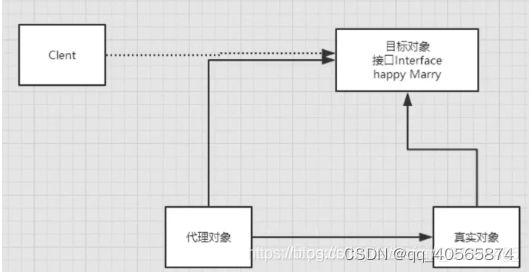
MyBatis详细执行流程

8.3 注解CURD
//方法存在多个参数,所有的参数前面必须加上@Param("id")注解
@Delete("delete from user where id = ${uid}")
int deleteUser(@Param("uid") int id);
关于@Param( )注解:
基本类型的参数或者String类型,需要加上
引用类型不需要加
如果只有一个基本类型的话,可以忽略,但是建议大家都加上
我们在SQL中引用的就是我们这里的@Param()中设定的属性名#{} 和 ${},使用井号安全一点(了解)
9、Lombok
Lombok项目是一个Java库,它会自动插入编辑器和构建工具中,Lombok提供了一组有用的注释,用来消除Java类中的大量样板代码。仅五个字符(@Data)就可以替换数百行代码从而产生干净,简洁且易于维护的Java类。
使用步骤:
1.在IDEA中安装Lombok插件

2.在项目中导入lombok的jar包
<dependency>
<groupId>org.projectlombok</groupId>
<artifactId>lombok</artifactId>
<version>1.18.10</version>
<scope>provided</scope>
</dependency>
@Getter and @Setter
@FieldNameConstants
@ToString
@EqualsAndHashCode
@AllArgsConstructor, @RequiredArgsConstructor and @NoArgsConstructor
@Log, @Log4j, @Log4j2, @Slf4j, @XSlf4j, @CommonsLog, @JBossLog, @Flogger, @CustomLog
@Data
@Builder
@SuperBuilder
@Singular
@Delegate
@Value
@Accessors
@Wither
@With
@SneakyThrows
@val
@Data
@AllArgsConstructor
@NoArgsConstructor
public class User {
private int id;
private String name;
private String password;
}
10、多对一处理
多个学生对应一个老师,
1、测试环境搭建
1.导入lombok
<dependency>
<groupId>org.projectlombok</groupId>
<artifactId>lombok</artifactId>
<version>1.18.10</version>
<scope>provided</scope>
</dependency>
2.新建实体类Teacher,Student
@Data
public class Student {
private int id;
private String name;
private Teacher teacher;
}
@Data
public class Teacher {
int id;
String name;
}
3.建立Mapper接口
public interface StudentMapper {
//查询所有的学生的信息,以及对应的;老师的信息!
public List<Student> getStudent();
public List<Student> getStudent1();
}
public interface TeacherMapper {
@Select("select * from teacher where id = 1")
Teacher SerchTeacherByID();
}
4.建立Mapper.xml文件
<!-- 在StudentMapper中写入-->
<mapper namespace="com.dao.StudentMapper">
<!-- 第一种方式:子查询的方式-->
<select id="getStudent" resultMap="StudentTeacher">
SELECT * from Student
</select>
<resultMap id="StudentTeacher" type="com.pojo.Student">
<result property="id" column="id"></result>
<result property="name" column="name"></result>
<!-- 复杂的属性我们要单独处理 对象:association 集合: collection-->
<association property="teacher" column="tid" javaType="Teacher" select="getTeacher"></association>
</resultMap>
<select id="getTeacher" resultType="com.pojo.Teacher">
select * from teacher where id = #{id}
</select>
<!-- 第二种方式:按照结果嵌套处理-->
<select id="getStudent1" resultMap="StudentTeacher1">
select s.id sid,s.name sname,t.name tname,t.id tid
from student s,teacher t
where s.tid=t.id
</select>
<resultMap id="StudentTeacher1" type="Student">
<result property="id" column="sid"></result>
<result property="name" column="sname"></result>
<association property="teacher" javaType="Teacher">
<result property="name" column="tname"></result>
<result property="id" column="tid"></result>
</association>
</resultMap>
</mapper>
<!-- TeacherMapper中暂时不写入-->
<mapper namespace="com.dao.TeacherMapper">
</mapper>
5.在核心配置文件中绑定注册我们的Mapper接口或者文件 【方式很多,随心选】
<mappers>
<mapper class="com.dao.TeacherMapper"></mapper>
<mapper class="com.dao.StudentMapper"></mapper>
</mappers>
6.测试查询是否能够成功
@Test
public void serarchStudent2(){
SqlSession sqlSession = MybatisUtils.getSqlSession();
StudentMapper student = sqlSession.getMapper(com.dao.StudentMapper.class);
List<Student> students = student.getStudent1();
for (int i = 0; i < students.size(); i++) {
System.out.println(students.get(i));
}
//关闭sqlSession
sqlSession.close();
}
10、处理一对多问题
一个老师拥有多个学生!对于老师来说就是一对多的问题
1、搭建环境
实体类:
@Data
public class Student {
private int id;
private String name;
private int tid;
}
@Data
public class Teacher {
int id;
private String name;
//一个老师拥有多个学生
private List<Student> students;
}
<!-- 获取指定老师的所有学生-->
<select id="getTeacher_Students" resultMap="StudentTeacher">
SELECT s.id sid, s.name sname,t.name tname,t.id tid FROM student s, teacher t WHERE s.tid = t.id AND tid = #{tid}
</select>
<resultMap id="StudentTeacher" type="Teacher">
<result property="id" column="tid"></result>
<result property="name" column="tname"></result>
<!--辅助的属性,我们需要单独处理 对象:association 集合:collection
JavaType=“指定属性的类型” 集合中的泛型信息,我们使用ofType获取
-->
<collection property="students" ofType="Student">
<result property="id" column="sid"></result>
<result property="name" column="sname"></result>
<result property="tid" column="tid"></result>
</collection>
</resultMap>
按照查询嵌套处理
<!--按照查询嵌套处理-->
<select id="getTeacher_Students1" resultMap="StudentTeacher1">
select * from teacher
</select>
<resultMap id="StudentTeacher1" type="Teacher">
<result property="id" column="id"></result>
<collection property="students" ofType="Student" select="selectStudentsByID" javaType="ArrayList" column="id">
</collection>
</resultMap>
<select id="selectStudentsByID" resultType="Student">
select * from student where tid = #{tid}
</select>
小结:
1.关联 - association 【多对一】
2.集合 - collection 【一对多】
3.javaType & ofType
1、JavaType用来指定实体类中的类型
2、ofType用来指定映射到List或者集合中的pojo类型,泛型中的约束类型
注意点:
- 保证SQL的可读性,尽量保证通俗易懂
- 注意一对多和多对一,属性名和字段的问题
- 如果问题不好排查错误,可以使用日志,建议使用Log4j
面试高频
- Mysql引擎
- InnoDB底层原理
- 索引
- 索引优化
12、动态SQL
什么是动态SQL:动态SQL就是根据不同的条件生成不同的SQL语句
所谓的动态SQL,本质上本质上还是SQL语句,只是我们可以在SQL层面,去执行一个逻辑代码
动态 SQL 是 MyBatis 的强大特性之一。如果你使用过 JDBC 或其它类似的框架,你应该能理解
根据不同条件拼接 SQL 语句有多痛苦,例如拼接时要确保不能忘记添加必要的空格,还要注意去
掉列表最后一个列名的逗号。利用动态 SQL,可以彻底摆脱这种痛苦。
搭建环境
CREATE TABLE `mybatis`.`blog` (
`id` int(10) NOT NULL AUTO_INCREMENT COMMENT '博客id',
`title` varchar(30) NOT NULL COMMENT '博客标题',
`author` varchar(30) NOT NULL COMMENT '博客作者',
`create_time` datetime(0) NOT NULL COMMENT '创建时间',
`views` int(30) NOT NULL COMMENT '浏览量',
PRIMARY KEY (`id`)
)
创建一个基础工程
1.导包
如果Junit测试在src中用不了,看看是不是Junit的使用范围有问题
<dependency>
<groupId>junit</groupId>
<artifactId>junit</artifactId>
<version>4.12</version>
<scope>test</scope>
</dependency>
其中scope显示为test范围,可以将其删除然后在任何文件下都可以使用。
2.编写配置文件
3.编写实体类
@lombok.Data
public class Blog {
private String id;
private String title;
private String author;
private Date createTime;
private int views;
}
4.编写实体类对应Mapper接口和Mapper.xml文件
Mapper接口:
public interface BlogMapper {
// 插入数据
int addBlog(Blog blog);
List<Blog> queryBlogIF(Map map);
}
Mapper.xml文件:
插入数据:
<!-- 类型大小写无所谓-->
<insert id="addBlog" parameterType="blog">
INSERT INTO blog (id, title, author, create_time, views) VALUES (#{id}, #{title}, #{author}, #{createTime}, #{views});
</insert>
使用IF进行查询数据:
<select id="queryBlogIF" parameterType="map" resultType="blog">
select * from blog where 1=1
<if test="title != null">
and title = #{title}
</if>
<if test="author != null">
and author = #{author}
</if>
</select>
插入数据测试代码:(演示)
@Test
public void serarchALlTeachers(){
SqlSession sqlSession = MybatisUtils.getSqlSession();
BlogMapper blogMapper = sqlSession.getMapper(BlogMapper.class);
Blog blog = new Blog();
blog.setId(IDutils.getID());
blog.setTitle("Mybatis如此之简单");
blog.setAuthor("狂神说");
blog.setCreateTime(new Date());
blog.setViews(999);
blogMapper.addBlog(blog);
blog.setId(IDutils.getID());
blog.setTitle("Java如此之简单");
blogMapper.addBlog(blog);
blog.setId(IDutils.getID());
blog.setTitle("Sping如此之简单");
blogMapper.addBlog(blog);
blog.setId(IDutils.getID());
blog.setTitle("微服务如此之简单");
blogMapper.addBlog(blog);
sqlSession.commit();
sqlSession.close();
}
使用IF属性进行连接查询代码测试:
@Test
public void quareIF(){
SqlSession sqlSession = MybatisUtils.getSqlSession();
BlogMapper blogMapper = sqlSession.getMapper(BlogMapper.class);
HashMap map = new HashMap() ;
map.put("author","狂神说");
// map.put("title","Java如此之简单");
List<Blog> blogs = blogMapper.queryBlogIF(map);
for (int i = 0; i < blogs.size(); i++) {
System.out.println(blogs.get(i));
}
sqlSession.close();
}
学习的元素种类:
if
choose (when, otherwise)
trim (where, set)
foreach
IF
使用动态 SQL 最常见情景是根据条件包含 where 子句的一部分。
例如:提供可选择的查找文本的功能,如果不传入“title”,那么处于“ACITVE”状态的BLOG都会返回;如果传入了“title”参数,那么就会对“title”一列进行模糊查找对应的BLOG结果
<select id="findActiveBlogWithTitleLike"
resultType="Blog">
SELECT * FROM BLOG
WHERE state = ‘ACTIVE’
<if test="title != null">
AND title like #{title}
</if>
</select>
通过两个字段查询:例如
<select id="queryBlogIF" parameterType="map" resultType="blog">
select * from blog where 1=1
<!-- <if test="title != null">
and title = #{title}
</if>
<if test="author != null">
and author = #{author}
</if>-->
/*通过两个参数进行查询搜索,使用like语句查询author字段以如此简单结尾的表*/
<if test="author != null and title != null">
and author like "*如此简单"
</if>
</select>
</mapper>
choose(when、otherwise)
有时候,我们不想使用所有的条件,而只是想从多个条件中选择一个使用。针对这种情况,MyBatis 提供了 choose 元素,它有点像 Java 中的 switch 语句。
按照顺序执行,从上到下,如果都没有传入,直接执行otherwise元素标签中连接SQL
<select id="queryBlogChoose" parameterType="map" resultType="blog">
select * from blog where 1 = 1
<choose>
<when test="view != null and title != null">
and id = "1da1e507aedc4aa588931eb86b16ce43"
</when>
<when test="author != null">
and author like #{author}
</when>
<otherwise>
and view = "100"
</otherwise>
</choose>
</select>
trim(where、set)
前面几个例子已经方便地解决了一个臭名昭著的动态 SQL 问题。
现在回到之前的 “if” 示例:
<select id="findActiveBlogLike"
resultType="Blog">
SELECT * FROM BLOG
WHERE
<if test="state != null">
state = #{state}
</if>
<if test="title != null">
AND title like #{title}
</if>
<if test="author != null and author.name != null">
AND author_name like #{author.name}
</if>
</select>
如果没有匹配的条件会怎么样?最终这条 SQL 会变成这样:导致查询会失败
SELECT * FROM BLOG
WHERE
MyBatis 有一个简单且适合大多数场景的解决办法。而在其他场景中,可以对其进行自定义以符合需求。where 元素只会在子元素返回任何内容的情况下才插入 “WHERE” 子句而且,若子句的开头为 “AND” 或 “OR”,where 元素也会将它们去除。
<select id="findActiveBlogLike"
resultType="Blog">
SELECT * FROM BLOG
<where>
<if test="state != null">
state = #{state}
</if>
<if test="title != null">
AND title like #{title}
</if>
<if test="author != null and author.name != null">
AND author_name like #{author.name}
</if>
</where>
</select>
*等价自定义:*通过自定义 trim 元素来定制 where 元素的功能。以下的例子:会移除所有 prefixOverrides 属性中指定的内容,并且插入 prefix 属性中指定的内容。
<trim prefix="WHERE" prefixOverrides="AND |OR ">
...
</trim>
用于动态更新语句的类似解决方案叫做 set。set 元素可以用于动态包含需要更新的列,忽略其它不更新的列。比如:
<update id="updateAuthorIfNecessary">
update Author
<set>
<if test="username != null">username=#{username},</if>
<if test="password != null">password=#{password},</if>
<if test="email != null">email=#{email},</if>
<if test="bio != null">bio=#{bio}</if>
</set>
where id=#{id}
</update>
set 元素等价的自定义 trim 元素,set 元素会动态地在行首插入 SET 关键字,并会删掉额外的逗号(这些逗号是在使用条件语句给列赋值时引入的)。
sql片段
有的时候,我们可能会将一些功能的部分抽取出来,方便服用!
1.使用SQL标签抽取公共部分可
2.在需要使用的地方使用Include标签引用即可
代码复用的实现:
<!--代码复用-->
<sql id="if-title-author">
<if test="title != null">
and title = #{title}
</if>
<if test="author != null">
and author = #{author}
</if>
</sql>
<select id="queryBlogIF1" parameterType="map" resultType="blog">
select * from blog where 1=1
<include refid="if-title-author"></include>
</select>
注意事项:
1、最好基于单标来定义SQL片段
2、不要存在where标签
动态SQL就是在拼接SQL语句,我们只要保证SQL的正确性,按照SQL的格式,去排列组合就可以了
建议:
先在Mysql中写出完整的SQL,再对应的去修改成我们的动态SQL实现通用即可
foreach
foreach 元素的功能非常强大,它允许你指定一个集合,声明可以在元素体内使用的集合项(item)和索引(index)变量。它也允许你指定开头与结尾的字符串以及集合项迭代之间的分隔符。这个元素也不会错误地添加多余的分隔符,看它多智能
<!-- select * from blog where 1=1 and (id =1 or id = 2 or id =3)-->
<select id="queryBlogForeach" parameterType="map" resultType="blog">
select * from blog
<where>
<foreach collection="ids" item="id" open="(" close=")" separator="or">
id = #{id}
</foreach>
</where>
</select>
测试代码:
@Test
public void quareForeach(){
SqlSession sqlSession = MybatisUtils.getSqlSession();
BlogMapper blogMapper = sqlSession.getMapper(BlogMapper.class);
HashMap map = new HashMap() ;
ArrayList<Integer> ids = new ArrayList<Integer>();
ids.add(1);
ids.add(2);
ids.add(3);
map.put("ids",ids);
List<Blog> blogs = blogMapper.queryBlogForeach(map);
for (int i = 0; i < blogs.size(); i++) {
System.out.println(blogs.get(i));
}
sqlSession.close();
}
13、缓存
13.1简介
查询 : 连接数据库,耗资源
一次查询的结果,给他暂存一个可以直接取到的地方 --> 内存:缓存
我们再次查询的相同数据的时候,直接走缓存,不走数据库了
1.什么是缓存[Cache]?
1.存在内存中的临时数据
2.将用户经常查询的数据放在缓存(内存)中,用户去查询数据就不用从磁盘上(关系型数据库文件)查询,从缓存中查询,从而提高查询效率,解决了高并发系统的性能问题
2.为什么使用缓存?
减少和数据库的交互次数,减少系统开销,提高系统效率
3.什么样的数据可以使用缓存?
经常查询并且不经常改变的数据 【可以使用缓存】
13.2 MyBatis缓存
MyBatis包含一个非常强大的查询缓存特性,它可以非常方便的定制和配置缓存,缓存可以极大的提高查询效率。
MyBatis系统中默认定义了两级缓存:一级缓存和二级缓存
- 默认情况下,只有一级缓存开启(SqlSession级别的缓存,也称为本地缓存)
- 二级缓存需要手动开启和配置,他是基于namespace级别的缓存。
- 为了提高可扩展性,MyBatis定义了缓存接口Cache。我们可以通过实现Cache接口来定义二级缓存。
mybatis提供了缓存机制减轻数据库压力,提高数据库性能。mybatis的缓存分为一级和二级两种:
一级缓存:SqlSession级别的缓存,缓存的数据只在SqlSession内有效
二级缓存:mapper级别的缓存,同一个namespace公用这一个缓存,所以对SqlSession是共享的
13.3 一级缓存
一级缓存也叫本地缓存:SqlSession
- 与数据库同一次会话期间查询带的数据会放在本地缓存中
- 以后如果需要获取相同的数据,直接从缓存中拿,没必要再去查询数据库
注意: - mybatis默认是开启一级缓存,不需要配置,同时也关闭不了。
- 如果SqlSession执行了DML操作(insert、update、delete),并commit了,那么mybatis就会清空当前SqlSession缓存中的所有缓存数据,这样可以保证缓存中存的数据永远和数据库中一致,避免出现脏读
- 一个SqlSession结束后那么它里面的一级缓存也就不存在了
- mybatis的缓存是基于[namespace:sql语句:参数]来进行缓存的。意思就是,SqlSession的HashMap存储缓存数据时,是使用[namespace:sql:参数]作为key,查询返回的语句作为value保存的。
测试步骤:
1、开启日志
2、测试在一个Session中查询两次记录
@Test
public void TestCache(){
SqlSession sqlSession = MybatisUtils.getSqlSession();
UserMapper userMapper = sqlSession.getMapper(UserMapper.class);
User user1 = userMapper.SearchUsersBYID(1);
System.out.println("");
System.out.println(user1);
System.out.println("==================================");
User user2 = userMapper.SearchUsersBYID(1);
System.out.println(user2);
sqlSession.close();
}
3、查看日志输出
从日志中可以看出,打开一级默认缓存后,相同的两次查询操作实际上只进行了一次。

缓存失效的情况:
1、查询不同的东西,不同的查询操作需要实现两次查询,但是相同的查询还是会在缓存中查询。(不同的查询缓存不同而已)但是相同的查询时缓存会有效。
@Test
public void TestCache(){
SqlSession sqlSession = MybatisUtils.getSqlSession();
UserMapper userMapper = sqlSession.getMapper(UserMapper.class);
User user1 = userMapper.SearchUsersBYID(1);
System.out.println("");
System.out.println(user1);
System.out.println("==================================");
User user2 = userMapper.SearchUsersBYID(2);
System.out.println(user2);
System.out.println("==================================");
User user3 = userMapper.SearchUsersBYID(1);
System.out.println(user3);
sqlSession.close();
}
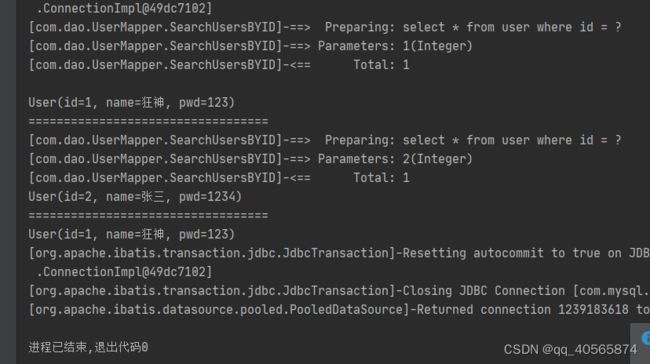
2、增删改操作,可能会改变原来的数据,所以必定会刷新缓存,
两次相同的查询中间添加一个数据更改操作,第一次的查询缓存失效,第二次相同的查询,需要再进行一次查询。
@Test
public void TestCache(){
SqlSession sqlSession = MybatisUtils.getSqlSession();
UserMapper userMapper = sqlSession.getMapper(UserMapper.class);
System.out.println("==================================");
User user1 = userMapper.SearchUsersBYID(1);
System.out.println(user1);
System.out.println("==================================");
User user2 = userMapper.SearchUsersBYID(2);
System.out.println(user2);
System.out.println("==================================");
User user = new User(1,"框框神","1234");
userMapper.UpdateUser(user);
User user3 = userMapper.SearchUsersBYID(1);
System.out.println(user3);
sqlSession.close();
}
@Test
public void TestCache(){
SqlSession sqlSession = MybatisUtils.getSqlSession();
UserMapper userMapper = sqlSession.getMapper(UserMapper.class);
System.out.println("==================================");
User user1 = userMapper.SearchUsersBYID(1);
System.out.println(user1);
System.out.println("==================================");
//清理缓存
sqlSession.clearCache();
User user3 = userMapper.SearchUsersBYID(1);
System.out.println(user3);
sqlSession.close();
}
小结:
一级缓存默认是开启的,只在一次SqlSession中有效,也就是拿到连接到关闭连接这个时间段!
一级缓存就是一个map
13.4 二级缓存
- 二级缓存也叫做全局缓存,一级缓存作用域太低了,所以诞生了二级缓存
- 基于namespace级别的缓存,一个名称空间,对应一个二级缓存
- 工作机制
1、一个会话查询一条数据,这个数据就会被放在当前会话的一级缓存中
2、如果会话关闭了,这个会员对应的一级缓存就没有了;但是我们想要的是,会话关闭了,一级缓存中的数据被保存到二级缓存中
3、新的会话查询信息,就可以从二级缓存中获取内容。
4、不同的mapper查询出的数据会放在自己对应的缓存(map)中 - 二级缓存需要手动开启和配置,他是基于namespace级别的缓存
- 为了提高可扩展性,MyBatis定义了缓存接口Cache。我们可以通过实现Cache接口来定义二级缓存。
步骤:
1、开启全局缓存
2、在Mapper.xml中使用缓存
<!--在当前Mapper.xml中使用二级缓存-->
<cache
eviction="FIFO"
flushInterval="60000"
size="512"
readOnly="true"/>
@Test
public void TestCache二级缓存(){
SqlSession sqlSession1 = MybatisUtils.getSqlSession();
UserMapper userMapper1 = sqlSession1.getMapper(UserMapper.class);
System.out.println("==================================");
User user1 = userMapper1.SearchUsersBYID(1);
System.out.println(user1);
sqlSession1.close();
SqlSession sqlSession2 = MybatisUtils.getSqlSession();
UserMapper userMapper2 = sqlSession2.getMapper(UserMapper.class);
System.out.println("==================================");
User user2 = userMapper2.SearchUsersBYID(1);
System.out.println(user2);
sqlSession2.close();
}
如果没有添加二级缓存,那么结果如下:会查询两次,(说明没有使用缓存)

如果添加了二级缓存:(查询了一次)
结果如下:使用了二级缓存,当第一个SqlSession关闭后,会将查询数据存到二级缓存中,第二个SqlSession的查询直接到二级缓存中查询。

测试问题:
1、问题一:我们需要将实体类序列化,否则就会报错
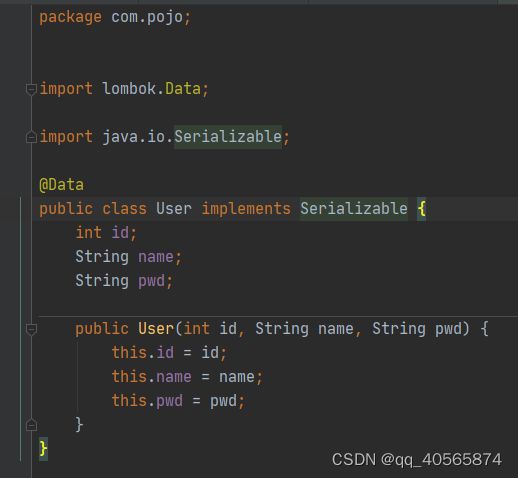
小结:
- 只要开启了,在同一个Mapper下都有效果
- 所有的数据都会先放在一级缓存中;
- 只有当会话提交,或者关闭的时候,再回提交到二级缓存中
13.5 缓存原理
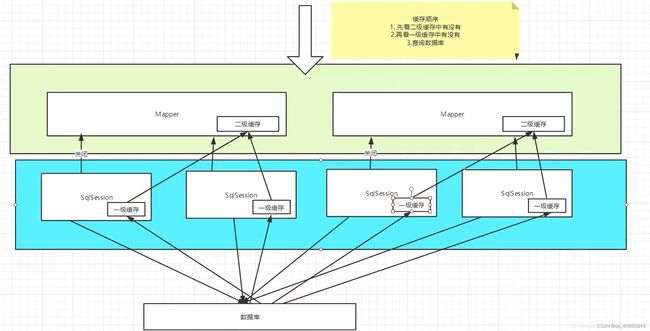
第一次查询的时候是先看二级缓存中有没有,然后查看一级缓存,最后才查询数据库有没有。
注意:
- 只有查询的时候才有缓存,根据数据是否需要缓存(修改是否频繁选择是否开启)useCache = “true”
<select id="getUserById" resultType="user" useCache="true">
select * from user where id = #{id}
</select>
13.6 自定义缓存-ehcache(了解一下)
Ehcache是一种广泛使用的开源Java分布式缓存。主要面向通用缓存
1、导包
<dependency>
<groupId>org.mybatis.caches</groupId>
<artifactId>mybatis-ehcache</artifactId>
<version>1.2.1</version>
</dependency>
2、在mapper中指定使用我们的ehcache缓存实现
<cache type="org.mybatis.caches.ehcache.EhcacheCache"/>
type属性指定的类必须实现org.mybatis.caches接口,且提供一个接受String参数作为id的构造器。这个接口是Mybatis框架中许多复杂的接口之一,但是行为却非常简单。
